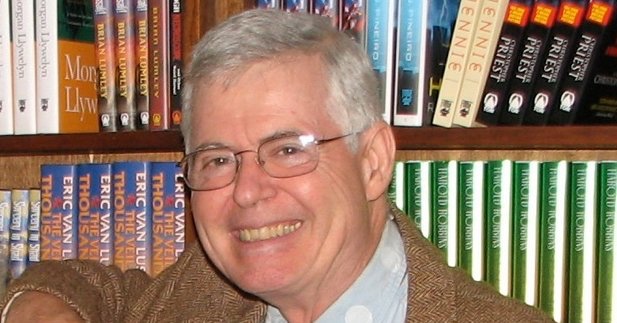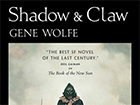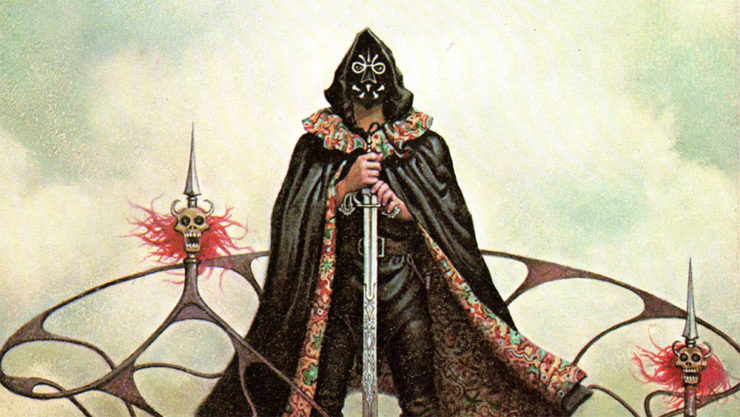I am no Severian.
Unlike the protagonist of Gene Wolfe’s seminal Book of the New Sun series, I’m not cursed with a perfect memory. But there are some moments that are too special to lose. Among those, for me, is the story of how I acquired a very special copy of The Shadow of the Torturer.
It was during the mass autographing session at the 2015 World Fantasy Con. Gene Wolfe was a guest of honor and I had stupidly forgotten my yellowed paperback of the Shadow & Claw omnibus at home. I was further distraught to learn that the dealer’s room was closed, so I couldn’t even buy another copy. I was somewhere between panic and heartbreak because Gene Wolfe just doesn’t come to conventions very often anymore and who knows if I’d ever meet him again.
My coworker of the past decade-plus, David G. Hartwell, must’ve seen the disappointment on my face, because he came up to me and asked me what was wrong. He was carrying, as he often did at mass signings, a duffle bag heavy with books. He was a great collector, to put it mildly. I told him my sad-sack story and without a millisecond of thought, he reached into his bag and pulled out an out-of-print, first edition hardcover of The Shadow of the Torturer. “Here,” he said, placing it in my hand. “You’d better get in line!”
I nearly cried with gratitude. And I got in line.
I’m nearly crying now, writing this, because that was the last real memory I have of my friend and co-worker; David passed away unexpectedly three months later.

We exchanged hellos and goodnights in the hallways back in the Tor offices after World Fantasy, but him giving me that copy of The Shadow of the Torturer is how I last remember David. I don’t remember my actual last words to him, because they were so ordinary, because you don’t ever think that the last time you see someone will be the last time you see someone. Gene Wolfe, maybe, but not a person you see almost every day. So I’d like to think that my last words to David were my “Thank you so much!” for that amazing, rare book and an unspoken thank you for his camaraderie, advice, and his sharing of so much accumulated genre knowledge over the years.
Besides, that copy of The Shadow of the Torturer brought the arc of our friendship to a neater, narrative circle than the truth.
Just because Severian has a perfect memory does not mean he never lies in order to tell a better story.
The start of the circle is this: I had been working at Tor Books for a little over a year, but had never spoken much to David Hartwell. Then I went to a World Horror Con in 2002 and the first person I saw in the lobby was my co-worker with the loud, terrible, amazing neckties: David. Surprisingly, neither of us knew the other loved horror so much (to say that is almost as much of an understatement as to say that David loved collecting books.)
I, being a twenty-something goth chick, was of course there to see the author guest of honor, Neil Gaiman, a year after American Gods’ publication. I’d never heard of the first-billed guest of honor, Gene Wolfe.
David was Gene’s editor for The Book of the New Sun.
Generous as David was with his time—and his books—he invited me to breakfast with this sharp-witted, mustachioed gentleman-author named Gene. And we were joined, unexpectedly, by Neil Gaiman, who had left his own breakfast table to come over and geek out over Gene. I’d never seen a faster, more genuine transition from rock star into happy fanboy. I had to give Gene Wolfe a try after that. Plus, you know, the book was called The Shadow of the Torturer and it’s about an executioner who wears a blacker-than-black cloak. That’s pretty goth, right? David gave me a copy of the Shadow & Claw omnibus from his office bookshelf. If only Neil (yeah, we’re not really on a first-name basis) had given me his advice on how to read Gene Wolfe that morning.
I was not prepared for Severian’s journey. I was even worse-equipped for Gene Wolfe’s prose.

Yes, there was torture and death, but it wasn’t at all horror. There were shadowy guilds and theater troupes and a badass sword and that damn blacker-than-black cloak, but it wasn’t fantasy.
And then there was a description of a painting that depicted the moon landing. Huh?
That casually-dropped clue, some sixty pages in, that Urth was not some magical alternate Earth, but our own planet—only so far into the future that civilization had fallen (or been terribly mismanaged) back into a medieval society long after a brief boom in interstellar travel—meant that, well, I guess The Book of the New Sun is science fiction, after all. Or not. What The Book of the New Sun is, without a doubt, is dense and subversive and imaginative and also ponderous and very much like getting thrown into the deep end of the pool. There is precious little exposition and very many words that sound made up but are actually mostly real, if archaic. Wolfe himself says Severian’s writing is “in a tongue that has not yet achieved existence.”
David wasn’t surprised by my first review. He told me to try it again sometime, that it would be different.
I’ve read The Book of the New Sun only once, but because I’ve never made time to read it again, I feel like I haven’t read the series at all. Severian’s ultimate fate demands it. Everything Severian says is suspect, every genre trope is self-aware, and we are all a bit closer to Urth than we were before, whether you read The Shadow of the Torturer when it was first published, or if you’re reading it now for the first time. It certainly feels more eerily relevant today; only the manner of climate change on Urth seems appreciably different, though the end result for humanity is much the same—dystopia, civil unrest, state-sanctioned torture, and a near-dogmatic disdain for science.
So, over a year after my friend’s death, I think I’m ready to return to Urth and appreciate so many things about Gene Wolfe’s masterwork that I couldn’t quite appreciate before, knowing what I do, knowing who I’ve known.
I will never get the chance to talk to Gene’s editor about The Book of the New Sun again, and it saddens me greatly. I’ll go into this book again without hand-holding, which intimidates me a bit.
This is the line of division brought down across my own reader’s journey that is now different than it was before. Terminus Est. This is the ending.
This is the beginning.
Theresa DeLucci is a regular contributor to Tor.com and her favorite color is fuligin. Follow her on Twitter.










